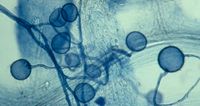Glomeromycota

Glomeromycota is one of eight currently recognized divisions within the kingdom Fungi, with approximately 230 described species. Members of the Glomeromycota form arbuscular mycorrhizas (AMs) with the thalli of bryophytes) and the roots of vascular land plants. The majority of evidence shows that the Glomeromycota are dependent on land plants (Nostoc in the case of Geosiphon) for carbon and energy, but there is recent circumstantial evidence that some species may be able to lead an independent existence. The arbuscular mycorrhizal species are terrestrial and widely distributed in soils worldwide where they form symbioses with the roots of the majority of plant species (>80%). They can also be found in wetlands, including salt-marshes, and associated with epiphytic plants. Arbuscular mycorrhizal (AM) fungi have generally been classified in the Zygomycota (Order Glomales), but they do not form the zygospores characteristic of zygomycota, and all ‘glomalean’ fungi form mutualistic symbioses. Recent molecular studies have suggested a separate phylum is appropriate for the AM fungi, the Glomeromycota.

Reproduction
Traditionally, taxonomy of AM fungi has been based on characteristics of the relatively large (40 to 800 µm diameter) multinucleate spores. There is no evidence that the Glomeromycota reproduce sexually. Studies using molecular marker genes have detected little or no genetic recombination so it is assumed generally that the spores are formed asexually. The Glomeromycota have generally coenocytic (occasionally sparsely septate) mycelia and reproduce asexually through blastic development of the hyphal tip to produce spores (Glomerospores) with diameters of 80–500 μm. In some, complex spores form within a terminal saccule.
Colonization
AM fungi are obligate symbionts and none of these fungi has been cultivated without their plant hosts. Pure fungal biomass can be obtained only from cultures in transformed plant roots that can be cultivated in tissue culture, but only a small number of AM species are available in this form. Most samples can be contaminated by numerous other microorganisms, including fungi from other phyla, so progress with multigene phylogenies has been slow and the nuclear-encoded ribosomal RNA genes have remained the only widely accessible molecular markers.
Yet, in ecological terms, this is possibly the most important group of fungi because AM fungi form endomycorrhizal associations with about 80% of land plants. The association is essential for plant ecosystem function because the plants depend on it for their mineral nutrient uptake, which is efficiently performed by the mycelium of the fungal symbionts that extends outside the roots. Within root cells AM fungi form hyphal coils or the typical tree-like structures, the arbuscules.
Some also produce storage organs, termed vesicles (hence, another frequently used name for them – vesicular-arbuscular mycorrhizas or VAM-fungi). In phylogenetic terms they are important because they are the oldest unambiguous fungi known from the fossil record (see the Fossil Fungi section in Chapter 2). Put these two facts together and you get the suggestion that early colonisation of the land surface on Earth was promoted by the success of this plant-fungal symbiosis.